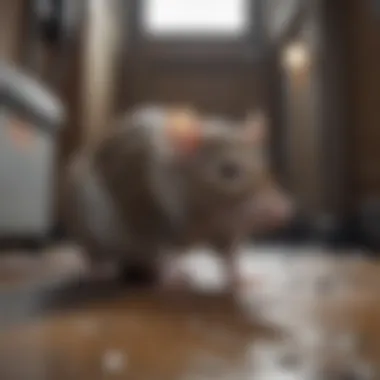Effective Strategies to Deter Rats in Your Space


Intro
Rats represent one of the most persistent and troublesome pests in both urban and rural settings. Their adaptability and ability to thrive in various environments make them a significant concern for house owners. Understanding the factors that attract rats and implementing effective deterrent strategies is crucial for maintaining a clean and safe living space. This article aims to inform readers about the behavioral patterns of rats, effective deterrent techniques, and sustainable pest control practices. By incorporating eco-friendly methods and proper sanitation, we can create less enticing environments for these rodents.
Understanding the Pest
Identification
Identifying the specific type of rat causing problems is essential for effective pest management. The two most common species are the Norway rat and the roof rat. Norway rats are larger and typically prefer living on the ground, while roof rats are smaller and tend to nest in elevated areas. Key features include their size, color, tail length, and ear development. Understanding these identifiers can help in determining suitable control measures.
Life Cycle
Rats reproduce rapidly, which contributes to their prevalence in human environments. A female rat can produce up to five litters each year, with an average of six to twelve pups per litter. The gestation period is approximately 21 to 23 days, allowing populations to grow swiftly. Identifying where rats are in their life cycle can help in selecting appropriate interventions.
Pest Prevention Strategies
Environment Modification
Effective rat control begins with environment modification. This involves reducing potential food sources and nesting sites. Simple strategies include:
- Sealing entry points: Close gaps and holes around foundations, pipes, and doors.
- Proper food storage: Keep food in sealed containers and manage garbage effectively.
- Decluttering: Remove debris and clutter that could serve as nesting materials.
Physical Barriers
Physical barriers can be a deterrent to rats. Installing barriers like rodent-proof fencing or using metal mesh to cover openings can prevent them from entering certain areas. It's also advisable to keep vegetation trimmed, as dense shrubbery can provide shelter for these pests.
Control Methods
Chemical Control
Chemical methods can be employed when non-lethal means are insufficient. Rodenticides are commonly used but must be applied with caution to avoid affecting non-target species. Always follow local regulations and professional guidance when using these products.
Biological Control
Biological control options, such as the introduction of natural predators, can be an effective method for managing rat populations. Birds of prey and certain breeds of cats can help reduce rodent numbers. However, this method requires careful consideration regarding balance within the ecosystem.
Successful rat control requires an understanding of their behavior and implementing comprehensive strategies tailored to the environment.
Developing an effective response to rat infestations involves a combination of identification, prevention strategies, and control methods. By harmonizing these approaches, households can enhance their defenses against these resourceful pests.
Intro to Rat Infestations
Understanding rat infestations is crucial for maintaining health and safety in urban and rural environments. These pests are often more than just a nuisance; they can lead to significant health risks and property damage. In many cases, timely intervention is essential to preventing larger infestations that can escalate swiftly if left unchecked.
Rats are known for their adaptability and resilience. They can thrive in a variety of environments, from densely populated city areas to isolated rural settings. The ease with which these rodents can enter homes and businesses makes it imperative for property owners to be informed about effective deterrent strategies. This section will delve into the specifics of rat species, addressing their characteristics, behavior, and the particular impacts they can have on human habitats.
Overview of Rat Species
There are two primary species of rats that typically cause concern for homeowners: the Norway rat and the roof rat. The Norway rat is larger, known for its burrowing ability, and often prefers ground-level environments. In contrast, the roof rat is more petite and favorably nest in trees and attics. Recognizing these species helps in choosing appropriate control methods. Both types can reproduce quickly, leading to formidable populations if not managed effectively.
Impact of Rat Infestations
Rats are associated with various health hazards. They are carriers of numerous diseases such as leptospirosis, hantavirus, and salmonella. These pathogens can spread through direct contact or even indirectly via contaminated food or surfaces. The potential economic impact is also significant. Damage to property, contamination of food supplies, and the costs related to pest control can be overwhelming.


The presence of rats can adversely affect mental well-being, causing anxiety or distress for those living in areas where infestations are apparent. Accordingly, understanding the behavior and patterns of these rodents will lead to effective strategies that serve both preventive and corrective purposes.
Understanding Rat Behavior
Understanding rat behavior is fundamental in managing rat populations effectively. Specific behavioral patterns provide insights into how these rodents navigate their environment, locate resources, and reproduce. By studying their habits, homeowners and pest control professionals can develop targeted strategies that prevent infestations before they occur. Key elements of rat behavior include their habitat preferences, feeding habits, and reproductive cycles. All of these factors are integral to creating an environment that is less hospitable to these pests.
Habitat Preferences
Rats, particularly Brown rats and Black rats, display distinct habitat preferences. They tend to gravitate towards warm and sheltered areas that provide easy access to food and water. This has implications for where to focus preventative measures. Common sites for rat nests include basements, attics, and areas around plumbing since these spots often offer shelter from predators and harsh weather conditions.
To deter rats, it is prudent to inspect these areas regularly. Possible entry points, including holes and cracks in the infrastructure, should be sealed promptly. Regular monitoring of external environments, especially near gardens or trash bins, will also help.
Feeding Habits
Rats are opportunistic feeders and will consume a wide variety of foods. Their diet typically consists of grains, fruits, and even meats. This omnivorous tendency means that food waste can quickly attract them to an area. Understanding these feeding habits can aid in controlling rat populations.
To deter rats, it is essential to:
- Store food in airtight containers.
- Maintain cleanliness in food preparation areas.
- Ensure trash is stored in securely closed bins.
These practices limit food sources, making locations less appealing to rats.
Reproduction and Nesting
Reproduction is a contributing factor to rat infestations. Female rats can reproduce at a startling rate, with litters consisting of up to a dozen young. This rapid reproductive cycle can lead to significant population growth if not managed effectively. Understanding how and where they nest will help mitigate these issues.
Rats prefer to nest in secluded, undisturbed areas near food sources. Locations such as behind appliances, in clutter, or in wall voids are common nesting spots. To reduce nesting opportunities:
- Clear clutter around homes and yards.
- Use sturdy bins for storage that do not allow nesting materials to accumulate.
By keeping environments clean and organized, one can significantly reduce the likelihood of rat infestation.
Key Deterrent Strategies
Key deterrent strategies are essential for effectively managing rat infestations. Implementing various methods can reduce the presence of rats significantly. These strategies focus on creating an environment that is unfriendly to rats and minimizing attractants that lure them. Furthermore, they encompass a blend of physical barriers, cleanliness efforts, natural aids, and if necessary, chemical options. Understanding how each of these strategies contributes to the overall goal of preventing rat infestations is crucial for households and businesses.
Physical Barriers
Physical barriers play a crucial role in preventing rats from entering homes and buildings. One of the most practical measures is sealing entry points.
Sealing Entry Points
Sealing entry points involves identifying and closing any openings where rats may enter. Cracks in walls, gaps around windows, and holes in foundations are common entry spots. By sealing these openings, homeowners effectively cut off access for rats. It is a popular choice because it not only deprives rats of entry but also enhances the overall insulation and security of the property.
However, a unique feature is the need for regular inspections. If gaps develop over time, they can become potential hiding places for rats again. Thus, while sealing entry points is advantageous, it requires ongoing vigilance to maintain effectiveness.
Utilizing Traps
Utilizing traps can be an immediate and effective way to control rat populations. Traps are designed to capture rats without the need for toxic chemicals. This method allows for precise targeting of the rodent problem. Different types of traps are available, such as snap traps and electronic traps. Electronic traps can kill rats instantly, which is often preferred by homeowners.
One key characteristic of traps is their ability to provide a physical solution without the use of hazardous substances. However, the challenge lies in knowing where to place traps for maximum effectiveness. The benefits of traps are clear, yet they require a degree of knowledge and manual intervention.
Fencing Solutions
Fencing solutions can serve as an additional barrier against rat invasions. A well-constructed fence can deter both rats and other pests. It acts as a visible boundary that rats may be reluctant to cross. Fencing is beneficial for outdoor spaces, especially gardens.
The unique aspect of fencing is that it can integrate natural features such as thorny plants. However, some disadvantages include maintenance needs and costs associated with installation. Thus, while fencing solutions contribute to the overall strategy against rats, they also require careful planning and investment.
Sanitation Practices


Sanitation practices are fundamental in keeping rats at bay. A clean environment is less attractive to them, reducing the likelihood of an infestation occurring.
Proper Storage of Food
Proper storage of food is vital for any household. Food should be stored in sealed containers that rats cannot penetrate. This practice not only prevents access but also minimizes smells that might attract rats.
The key feature of proper storage is its simplicity. It is an easy habit to adopt and can have a substantial impact on rodent attraction. However, this requires consistency, as failure to properly store even small amounts can invite pests.
Trash Management Techniques
Effective trash management techniques are equally important. Ensure trash is regularly disposed of and placed in secured containers. This minimizes the chances that rats might scavenge for food.
The significant characteristic of this strategy is its ability to reduce the overall food supply available to rats. This practice is essential for both households and businesses alike. The downside may be the effort required in maintaining proper organization, but it pays off by keeping rats at bay.
Regular Cleaning Routines
Regular cleaning routines also help in deterring rats. Maintaining cleanliness in and around the home limits potential nesting areas.
One key advantage of regular cleaning is the reduction of clutter, which is a common hiding place for rodents. Establishing a cleaning routine is a beneficial and proactive practice. However, it requires commitment to ensure that areas remain clean over time.
Natural Deterrents
Natural deterrents provide alternatives to chemical solutions for pest control. These methods utilize natural elements to discourage rats from invading spaces.
Essential Oils
Essential oils like peppermint and eucalyptus are known for their strong scents which can repel rats. Spraying these oils around entry points might deter rat movements.
One key aspect is their non-toxic nature, making them safe for households with children or pets. However, the scent may fade over time, requiring frequent reapplications. Thus, while they are effective, they need consistent use to maintain potency.
Plants that Repel Rats
Some plants naturally deter rats through their scent. Plants like mint or marigold can be strategically placed around homes to repel these pests.
The characteristic of these plants is their dual role in beautifying the environment while also serving a protective function. However, the effectiveness can vary and may require trials to identify the most suitable options for specific environments.
Sound Deterrents
Sound deterrents are innovative ways to keep rats away. Devices that emit high-frequency sound waves can be effective in repelling rodents.
The unique feature is that these sounds are inaudible to humans but can drive rats away. While they offer a high-tech solution, their effectiveness can be influenced by environmental factors and may not always guarantee success.
Chemical Deterrents
Chemical deterrents please a part of the broader rat control strategy. They provide a more aggressive form of management but come with considerations.
Rodenticides: Use and Risks
Rodenticides are chemical substances used to eliminate rats. They are effective in reducing populations but should be used with caution.
The key characteristic of rodenticides is their potency; however, there are risks involved, especially in households with pets or children. Careful application and awareness of potential hazards are critical when considering this option.
Non-toxic Alternatives
Non-toxic alternatives to traditional rodenticides are gaining popularity. These solutions target rats using natural ingredients that are less harmful.
The advantage of non-toxic alternatives is that they minimize risks to humans and pets, making them a safer option. However, their effectiveness may not match that of conventional methods and might require more applications to see results.
Application Guidelines
Application guidelines for chemical deterrents are crucial for safe and effective usage. Understanding the correct dosages and application duration is necessary to avoid adverse effects.
One important feature is adherence to these guidelines to ensure effectiveness while minimizing risk. Improper application can lead to ineffectiveness and potential harm to non-target species. This underscores the need for careful consideration and strict adherence to recommendations.
Technological Interventions
Technological interventions represent a significant leap forward in the fight against rat infestations. These methods not only improve efficiency but also enhance the ability to monitor and manage rodent populations with precision. Given the increasing challenges posed by rats, traditional methods may not suffice. Technological solutions complement old strategies and provide innovative pathways to deter these pests more effectively.
Through advancements, householders can now access tools that offer real-time monitoring, automated responses, and smarter detection systems. These elements not only offer convenience but also advance sustainability in pest management strategies. The integration of technology into rat control emphasizes a proactive approach—monitoring and addressing infestations before they escalate.
Smart Traps


Smart traps symbolize a new era in rodent control. Unlike traditional traps, smart traps are designed with sensors that detect the presence of rats. Once activated, they can capture, and in some designs, even kill the rat instantly. These traps often send alerts to users’ smartphones or other devices, providing immediate feedback. Consequently, homeowners can monitor their properties without needing to check traps constantly.
Advantages include:
- Immediate Notifications: Users receive alerts when a rodent is caught, ensuring prompt action.
- Data Collection: Many smart traps record information on rat activity, helping homeowners understand patterns of infestation.
- Humane Options: Some smart traps are designed to catch rats alive, allowing for relocation rather than extermination.
Homeowners adopting smart traps can significantly reduce the chance of future infestations through better understanding and timely responses.
Rodent Deterrent Devices
Rodent deterrent devices utilize various technologies to repel rats before they invade homes. These devices often utilize sound waves, vibrations, or even infrared technology to create an uncomfortable environment for rodents. For example, ultrasonic repellents emit high-frequency sounds that are inaudible to humans but disturb rats, discouraging them from approaching the area.
Key points to consider regarding these devices include:
- Effectiveness: Different devices may have varying degrees of success based on factors like frequency and home architecture.
- Maintenance-Free: Many deterrent devices require little to no regular maintenance, saving time for homeowners.
- Environment Friendly: Most deterrents do not rely on chemicals, aligning with eco-friendly pest control principles.
Long-term Management Solutions
Long-term management solutions are critical in effectively controlling rat populations. Many homeowners believe that immediate responses, such as traps or poisons, will resolve the issues. However, these methods often do not address the root causes of infestations. By implementing long-term strategies, one can create an environment that actively discourages rats from returning.
Monitoring and Evaluation
To maintain effective pest control, consistent monitoring and evaluation are necessary. Regular inspections of both indoor and outdoor areas can help identify signs of rodent activity before it escalates. Look for droppings, nests, and gnaw marks to assess if rats are present.
Keeping a log of findings and actions taken can provide valuable insights into patterns of rat behavior. This data helps homeowners understand fluctuations in activity and effectiveness of implemented strategies. Monitoring should not be a one-time or seasonal task. Instead, it should be woven into routine household maintenance to proactively manage risks.
Community Involvement
Community involvement plays a significant role in long-term pest management. When neighbors work together, they can create a unified approach to rodent control. It is important to share knowledge about effective deterrent strategies, as well as maintain open communication about any sightings of rats.
Organizing community cleanup days can help eliminate potential habitats and food sources for rats. Educating others on proper waste disposal and sanitation practices fosters a shared responsibility among neighbors. This collective effort can significantly minimize the chances of infestations spreading within and between properties.
"Effective long-term strategies for controlling rat populations require continuous effort and collaboration within the community."
By fostering a cooperation framework through local meetings or informal gatherings, residents can increase awareness and enhance overall prevention measures.
Incorporating these long-term management solutions not only helps manage current infestations but also lays the groundwork for lasting pest control success.
Epilogue
The topic of deterring rats is crucial for maintaining a healthy and comfortable living environment. With the increasing challenges posed by rat infestations, understanding the methods available is essential for homeowners and housewives. This article has provided insights into rat behavior, effective deterrent strategies, and the importance of long-term management.
Summary of Effective Practices
To effectively deter rats, it is important to consider a combination of strategies:
- Physical Barriers: Sealing entry points and utilizing traps are essential in preventing rats from entering homes.
- Sanitation Practices: Keeping food stored properly and managing trash effectively reduces the food sources available for rats.
- Natural and Chemical Deterrents: Using essential oils, plants that repel rats, and careful application of rodenticides can help manage infestations without compromising safety.
- Technological Solutions: Innovative devices such as smart traps can enhance detection and control measures.
These practices not only aim to eliminate existing rats but also prevent future infestations, which is critical for household management.
Future Directions in Rodent Control
As pest control methods evolve, several future directions can be anticipated in rat deterrence:
- Research and Development: Increased investment in research may lead to more effective and eco-friendly deterrent solutions.
- Community-based Approaches: Collaborative efforts among neighbors to monitor and manage rodent populations can enhance effectiveness.
- Technology Advancement: The integration of IoT (Internet of Things) devices in pest control could streamline monitoring and create more proactive responses to infestations.
As these strategies continue to develop, homeowners can stay informed and adapt their approaches, contributing to a more sustainable and healthier living environment.
"A proactive and informed strategy is the best way to deter rats effectively."







